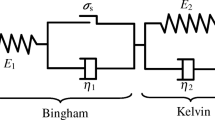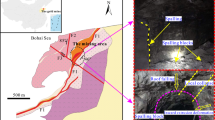Abstract
Complex jointed rock masses are common in nature. When a roadway is located in complex jointed rock mass, numerous joints can weaken the strength of surrounding rock, resulting in large deformation of the roadway and impact on mine production. In this paper, a DFN–DEM jointed roadway model was constructed based on discrete element method, with the failure characteristics and layout optimization of roadway analyzed. Also, the mechanical properties of jointed rock masses with different sizes and rotation angles were numerically investigated. And the failure and deformation characteristics of jointed roadway with different layout angles were analyzed. The results demonstrated that the UCS of jointed rock masses under different loading directions are significantly different, with an RVE size of 6 m. UCS of the jointed rock masses reaches maximum value at the rotation angles of 30° and −60°, and the average UCS of rock masses has a positively relationship with the joint density P30. The shear instability of joints results in the macro-failure of rock masses, and brings about the asymmetric failure of jointed roadway. The layout angle of jointed roadway can significantly affect its failure and deformation characteristics. With the roadway axial direction adjusted to −60° relative to the direction of principal stress, the deformation degree of the surrounding rock reached minimum values. In engineering practice, an optimal layout angle and supporting of jointed roadway are effective for avoiding the large deformation of surrounding rock.






















Similar content being viewed by others
References
Kang HP, Gao FQ, Xu G, Ren HW (2023) Mechanical behaviors of coal measures and ground control technologies for China’s deep coal mines: a review. J Rock Mech Geotech 15:37–65. https://doi.org/10.1016/j.jrmge.2022.11.004
Zhao YM, Feng XT, Jiang Q, Han Y, Zhou YY, Guo HG, Kou YY, Shi YE (2021) Large deformation control of deep roadways in fractured hard rock based on cracking-restraint method. Rock Mech Rock Eng 54:2559–2580. https://doi.org/10.1007/s00603-021-02384-4
Zhan QJ, Zheng XG, Du JP, Xiao T (2020) Coupling instability mechanism and joint control technology of soft-rock roadway with a buried depth of 1336 m. Rock Mech Rock Eng 53:2233–2248. https://doi.org/10.1007/s00603-019-02027-9
Zang CW, Chen M, Zhang GC, Wang K, Gu DD (2020) Research on the failure process and stability control technology in a deep roadway: numerical simulation and field test. Energy Sci Eng 8:2297–2310. https://doi.org/10.1002/ese3.664
Zhan QJ, Shahani NM, Zheng XG, Xue ZC, He YY (2022) Instability mechanism and coupling support technology of full section strong convergence roadway with a depth of 1350 m. Eng Fail Anal 139:106374. https://doi.org/10.1016/j.engfailanal.2022.106374
Liu J, Lu P, Zhang LW (2022) Influence of section shape and buried depth on rock loosening zone around underground roadway in coal mine. ACS Omega 7:34296–34308. https://doi.org/10.1021/acsomega.2c03811
Zhu DF, Wu YH, Liu ZH, Dong XQ, Yu J (2020) Failure mechanism and safety control strategy for laminated roof of wide-span roadway. Eng Fail Anal 111:104489. https://doi.org/10.1016/j.engfailanal.2020.104489
Xiong XY, Dai J, Ouyang YB, Shen P (2021) Experimental analysis of control technology and deformation failure mechanism of inclined coal seam roadway using non-contact DIC technique. Sci Rep 11:20930. https://doi.org/10.1038/s41598-021-00462-9
Liu XF, Zhou YY, Xu DP (2023) Anisotropic mechanical properties of quartz mica schist subjected to true triaxial compression. Environ Earth Sci 82:204. https://doi.org/10.1007/s12665-023-10886-3
Vitali OPM, Celestino TB, Bobet A (2020) Analytical solution for a deep circular tunnel in anisotropic ground and anisotropic geostatic stresses. Rock Mech Rock Eng 53:3859–3884. https://doi.org/10.1007/s00603-020-02157-5
Gao CL, Zhou ZQ, Li LP, Li ZH, Zhang DS, Cheng S (2021) Strength reduction model for jointed rock masses and peridynamics simulation of uniaxial compression testing. Geomech Geophys Geo 7:34. https://doi.org/10.1007/s40948-021-00232-x
Liu HY, Lv SR, Zhang LM, Yuan XP (2015) A dynamic damage constitutive model for a rock mass with persistent joints. Int J Rock Mech Min Sci 75:132–139. https://doi.org/10.1016/j.ijrmms.2015.01.013
Wang CX, Zhang SC, Zhang BC, Sun J, Chen LL (2020) Failure characteristics and physical signals of jointed rock: an experimental investigation. Arab J Geosci 13:628. https://doi.org/10.1007/s12517-020-05675-2
Yang WD, Zhang QB, Ranjith PG, Yu RG, Luo GY, Huang CC, Wang G (2019) A damage mechanical model applied to analysis of mechanical properties of jointed rock masses. Tunn Undergr Space Technol 84:113–128. https://doi.org/10.1016/j.tust.2018.11.004
Yang XX, Jing HW, Tang CA, Yang SQ (2017) Effect of parallel joint interaction on mechanical behavior of jointed rock mass models. Int J Rock Mech Min Sci 92:40–53. https://doi.org/10.1016/j.ijrmms.2016.12.010
Zhou Y, Wu SC, Gao YT, Misra A (2014) Macro and meso analysis of jointed rock mass triaxial compression test by using equivalent rock mass (ERM) technique. J Cent South Univ 21:1125–1135. https://doi.org/10.1007/s11771-014-2045-x
Lin ZN, Xu WY, Wang W, Wang HL, Wang RB, Ji H, Zhang JC (2018) Determination of strength and deformation properties of columnar jointed rock mass using physical model tests. KSCE J Civ Eng 22(9):3302–3311. https://doi.org/10.1007/s12205-018-0257-6
Gao G, Meguid MA, Chouinard LE (2020) On the role of pre-existing discontinuities on the micromechanical behavior of confined rock samples: a numerical study. Acta Geotech 15:3483–3510. https://doi.org/10.1007/s11440-020-01037-0
Ju MH, Xing HZ (2022) Crack propagation in jointed rock and its effect on rock macrofracture resistance: insights from discrete element analysis. Geomech Geophys Geo 8:21. https://doi.org/10.1007/s40948-021-00326-6
Lin QB, Cao P, Meng JJ, Cao RH, Zhao ZY (2020) Strength and failure characteristics of jointed rock mass with double circular holes under uniaxial compression: Insights from discrete element method modelling. Theor Appl Fract Mech 109:102692. https://doi.org/10.1016/j.tafmec.2020.102692
Yao DH, Jiang N, Wang XJ, Jia XD, Lv K (2022) Mechanical behaviour and failure characteristics of rocks with composite defects of different angle fissures around hole. Bull Eng Geol Environ 81:290. https://doi.org/10.1007/s10064-022-02783-z
Li YG, Zhang HM, Chen M, Meng XZ, Shen YJ, Liu H, Lu YN (2022) Strength criterion of rock mass considering the damage and effect of joint dip angle. Sci Rep 12:2601. https://doi.org/10.1038/s41598-022-06317-1
Gao W, Chen X, Hu CJ (2022) Study on interfacial crack initiation of jointed rock mass based on interface fracture mechanics. Fractal Fract 6(9):510. https://doi.org/10.3390/fractalfract6090510
Han DY, Li KH, Meng JJ (2020) Evolution of nonlinear elasticity and crack damage of rock joint under cyclic tension. Int J Rock Mech Min Sci 128:104286. https://doi.org/10.1016/j.ijrmms.2020.104286
Li G, Ma FS, Guo J, Zhao HJ (2022) Experimental research on deformation failure process of roadway tunnel in fractured rock mass induced by mining excavation. Environ Earth Sci 81:243. https://doi.org/10.1007/s12665-022-10364-2
Moussaeia N, Sharifzadehb M, Sahriarc K, Khosravia MH (2019) A new classification of failure mechanisms at tunnels in stratified rock masses through physical and numerical modeling. Tunn Undergr Sp Tech 91:103017. https://doi.org/10.1016/j.tust.2019.103017
Zhao DC, Xia YJ, Zhang CQ, Tang CA, Zhou H, Liu N, Singh HK, Zhao ZX, Chen J, Mu CQ (2022) Failure modes and excavation stability of large-scale columnar jointed rock masses containing interlayer shear weakness zones. Int J Rock Mech Min Sci 159:105222. https://doi.org/10.1016/j.ijrmms.2022.105222
Xue XR, Zhang K, Chen WM, Liu H, Ma BL, Liu T, Cao H (2023) A 3D Ubiquitous-Multiple-Joint model and its application to the stability analysis of TBM excavated roadway in jointed stratum. Rock Mech Rock Eng 56:1343–1366. https://doi.org/10.1007/s00603-022-03100-6
Bai QS, Tu SH (2020) Numerical observations of the failure of a laminated and jointed roof and the effective of different support schemes: a case study. Environ Earth Sci 79:202. https://doi.org/10.1007/s12665-020-08935-2
Xi PQ, Zhu DF, Huo YM, Xing CN, Wang ZL (2022) Numerical investigation of the failure mechanism and countermeasures of the roadway surrounding rockmass within deep soft rock. Int J Multiscale Comput 20(4):17–41. https://doi.org/10.1615/IntJMultCompEng.2022041399
Ma C, Yao WM, Yao Y, Li J (2018) Simulating strength parameters and size effect of stochastic jointed rock mass using dem method. KSCE J Civ Eng 22(12):4872–4881. https://doi.org/10.1007/s12205-017-1581-y
Wang X, Cai M (2020) A DFN–DEM Multi-scale modeling approach for simulating tunnel excavation response in jointed rock masses. Rock Mech Rock Eng 53:1053–1077. https://doi.org/10.1007/s00603-019-01957-8
Yin TC, Chen QF (2020) Simulation-based investigation on the accuracy of discrete fracture network (DFN) representation. Comput Geotech 121:103487. https://doi.org/10.1016/j.compgeo.2020.103487
Mauldon M (1998) Estimating mean fracture trace length and density from observations in convex windows. Rock Mech Rock Eng 31:201–216. https://doi.org/10.1007/s006030050021
Zhao DC, Xia YJ, Zhang CQ, Liu N, Tang CA, Singh HK, Chen J, Wang P (2023) A new method to investigate the size efect and anisotropy of mechanical properties of columnar jointed rock mass. Rock Mech Rock Eng 56:2829–2859. https://doi.org/10.1007/s00603-022-03200-3
Gao FQ, Stead D, Kang HP (2015) Numerical simulation of squeezing failure in a coal mine roadway due to mining-Induced stresses. Rock Mech Rock Eng 48:1635–1645. https://doi.org/10.1007/s00603-014-0653-2
Gottron D, Henk A (2021) Upscaling of fractured rock mass properties: an example comparing discrete fracture network (DFN) modeling and empirical relations based on engineering rock mass classifications. Eng Geol 294:106382. https://doi.org/10.1016/j.enggeo.2021.106382
Qi ZW, Wang PT, Zhang B, Lan F, Zhang HW, Yuan W, Yan XW, Cao XY (2022) Investigation of preparation of jointed models and the experimental evaluation of mechanical behavior based on 3D printing. J China Coal Soc 2022. (in Chinese) https://doi.org/10.13225/j.cnki.jccs.2022.1544
Niu QJ, Jiang LS, Li CA, Zhao Y, Wang QB, Yuan AY (2023) Application and prospects of 3D printing in physical experiments of rock mass mechanics and engineering: materials, methodologies and models. Int J Coal Sci Technol 10:5. https://doi.org/10.1007/s40789-023-00567-8
Acknowledgements
This research was financially supported by the State Key Laboratory of Coal Mine Disaster Dynamics and Control Visiting Scholar Fund Project (Grant NO.2011DA105287--FW201805), Basic Research Funds of China University of Mining and Technology (Beijing)-Doctoral Outstanding Innovation Talent Cultivation Fund (BBJ2023004), Fundamental Research Funds for the Central University's Graduate Students Research and Innovation Ability Improvement Project (2022YJSNY12), Hebei Province Ecological Wisdom Mine Joint Fund Project (E2020402036).
Funding
Basic Research Funds of China University of Mining and Technology (Beijing)-Doctoral Outstanding Innovation Talent Cultivation Fund, BBJ2023004, Hui Cheng, Fundamental Research Funds for the Central University's Graduate Students Research and Innovation Ability Improvement Project, 2022YJSNY12, Hongbao Zhao, Hebei Province Ecological Wisdom Mine Joint Fund Project, E2020402036, Hongbao Zhao.
Author information
Authors and Affiliations
Contributions
Hui Cheng and Hongbao Zhao contributed to conceptualization and methodology; Xiaokang Xie and Hongbao Zhao contributed to formal analysis; Hui Cheng contributed to validation; Hui Cheng contributed to writing—original draft; Xiaokang Xie and Hongbao Zhao contributed to writing—review and editing.
Corresponding author
Ethics declarations
Conflict of interest
The authors declare no conflicts of interest.
Additional information
Publisher's Note
Springer Nature remains neutral with regard to jurisdictional claims in published maps and institutional affiliations.
Rights and permissions
Springer Nature or its licensor (e.g. a society or other partner) holds exclusive rights to this article under a publishing agreement with the author(s) or other rightsholder(s); author self-archiving of the accepted manuscript version of this article is solely governed by the terms of such publishing agreement and applicable law.
About this article
Cite this article
Cheng, H., Zhao, H. & Xie, X. Deformation characteristics and layout optimization of roadway in complex jointed rock mass: a case study based on discrete element method. Comp. Part. Mech. (2023). https://doi.org/10.1007/s40571-023-00701-y
Received:
Revised:
Accepted:
Published:
DOI: https://doi.org/10.1007/s40571-023-00701-y




